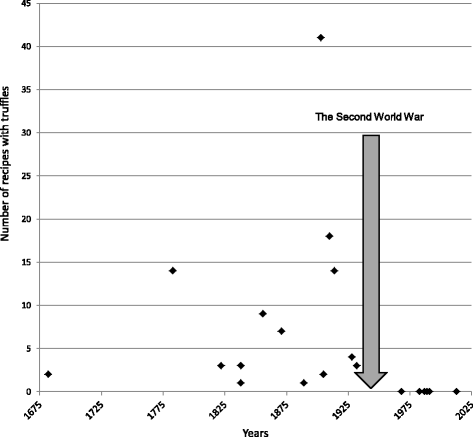Truffle renaissance in Poland - history, present and prospects
- PMID: 28619090
- PMCID: PMC5473005
- DOI: 10.1186/s13002-017-0163-x
Truffle renaissance in Poland - history, present and prospects
Abstract
The use of truffles in Poland has a long tradition, yet due to some historical aspects, this knowledge was lost. Currently, truffles and truffle orchards are again receiving attention, and thanks to, e.g., historical data, they have solid foundations to be established. Publications relating to truffles between 1661 and 2017 were searched for in international and national databases, such as the database of PhD theses, Google Scholar, and catalogues of the National Library of Poland, the Jagiellonian Digital Library, the University Library of J. Giedroyc in Bialystok and the Lower Silesian Digital Library (DBC). A very meticulous survey of the literature on truffles showed that truffles have been known since at least 1661. In the 18th century, the fungi were considered a non-timber forest product. It is interesting to mention the impact of Polish Count Michał Jan Borch in understanding the nature of truffles. The whitish truffle (Tuber borchii) is named after him. The greatest number of publications regarding truffles can be observed at the first half of the 19th and 20th centuries. The fungi were present not only in cookbooks but also in scientific literature, and aspects of their ecology and medicinal use are considered. The "dark ages" for truffles, mainly for social reasons, occurred after the Second World War. In tough times, when Poland was under Soviet communist control (1945-1989), truffles as a luxurious product have been completely forgotten. However, at the end of the 20th century, truffles started receiving attention in Polish society. Yet, the real awakening began in the first decade of the twenty-first century when the first truffle orchards were established. One of them has already produced the first fruit bodies of summer truffle (Tuber aestivum). Truffles have been present in Polish culture for centuries. Their renaissance indicates the need for fostering sustainable agroforestry-centred initiatives aimed at helping truffle growers in growing the precious fungi and thus meeting market demands.
Keywords: Cuisine; Ethnomycology; Historical data; Poland; Truffles.
Figures
References
-
- Figliuolo G, Trupo G, Mang S. A realized Tuber magnatum niche in the upper Sinni area (south Italy) Open J Genet. 2013;3(2):102. doi: 10.4236/ojgen.2013.32013. - DOI
-
- Riccioni C, Rubini A, Belfiori B, Gregori G, Paolocci F. True truffle (Tuber spp.) in the world. Switzerland: Springer; 2016. Tuber magnatum: the special one. What makes it so different from the other Tuber spp.? pp. 87–103.
Publication types
MeSH terms
LinkOut - more resources
Full Text Sources
Other Literature Sources



